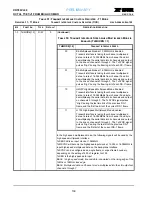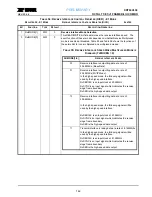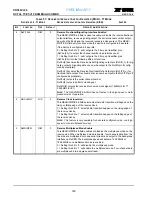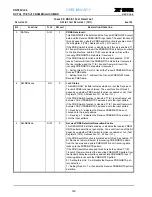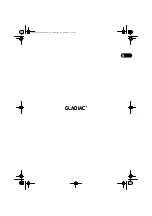
XRT86VL38
PRELIMINARY
xr
OCTAL T1/E1/J1 FRAMER/LIU COMBO
REV. P1.0.6
135
1-0
TxIMODE[1:0]
R/W
0
(Continued)
:
In the high speed multiplexed mode, the following signals will be used
by the high speed multiplexed interface:
TxSERCLK is an input clock at 2.048MHz
TxMSYNC will become the high speed input clock at 16.384MHz to
input high-speed multiplexed data on the back-plane interface
TxSYNC is the single multiplexed frame boundary
TxSER is the high-speed data input
N
OTE
: In high speed mode, transmit data is sampled on the rising edge
of the 16MHz clock edge. Multiplexed data on Channel 4 is de-multi-
plexed into the LIU outputs at channel 4 through 7.
T
ABLE
48: T
RANSMIT
I
NTERFACE
C
ONTROL
R
EGISTER
- E1 M
ODE
R
EGISTER
31 - E1 M
ODE
T
RANSMIT
I
NTERFACE
C
ONTROL
R
EGISTER
(TICR) H
EX
A
DDRESS
:0
X
n120
B
IT
F
UNCTION
T
YPE
D
EFAULT
D
ESCRIPTION
-O
PERATION
T
ABLE
50: T
RANSMIT
I
NTERFACE
S
PEED
WHEN
M
ULTIPLEXED
M
ODE
IS
E
NABLED
(T
X
MUXEN = 1)
T
X
IMODE[1:0]
T
RANSMIT
I
NTERFACE
S
PEED
00
Reserved
01
Bit Multiplexed Mode is Enabled:
The transmit interface is taking four-channel multi-
plexed data at a rate of 16.384Mbit/s from channel
0 and bit-demultiplexing the serial data into 4 chan-
nels and output to the line on channels 0 through 3.
The TxSYNC signal pulses “High” during the first bit
of each E1 frame.
10
HMVIP High-Speed Multiplexed Mode Enabled:
Transmit interface is taking four-channel multi-
plexed data at a rate of 16.384Mbit/s from channel
0 and byte-demultiplexing the serial data into 4
channels and output to the line on channels 0
through 3. The TxSYNC signal pulses “High” during
the last two bits of the previous E1 frame and the
first two bits of the current E1 frame.
11
H.100 High-Speed Multiplexed Mode Enabled:
Transmit interface is taking four-channel multi-
plexed data at a rate of 16.384Mbit/s from channel
0 and byte-demultiplexing the serial data into 4
channels and output to the line on channels 0
through 3. The TxSYNC signal pulses “High” during
the last bit of the previous E1 frame and the first bit
of the current E1 frame.



















